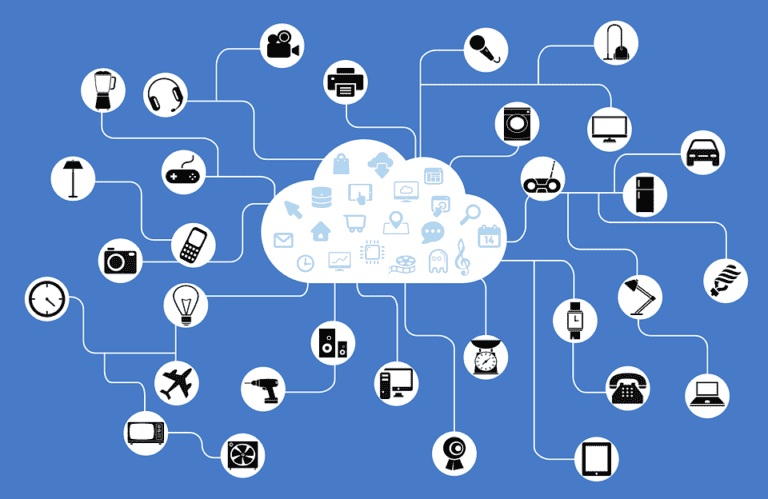The proliferation of wireless internet connectivity has created a world where many of our devices are interconnected, beyond just our phones and computers. Appliances like coffeemakers, washing machines, and even light bulbs now support WiFi connectivity. Whereas, some of the devices run on z-wave or Zigbee mesh networks as well.
IoT or “The Internet of Things” is the all-inclusive term used to collectively identify these previously disconnected devices that are now internet-connected. It also refers to the idea that, going forward, nearly every device that can be connected will be connected.
This is advantageous because interconnectivity between devices means that, for the first time, devices can interact and communicate with one another.
For example, imagine that you’ve got a planned two-week vacation booked in your phone’s calendar. Your phone could then transmit this data to your house’s lights, which would then automatically turn off for the duration of those two weeks – just in case you forgot to flip a certain switch!
On a broader scale, the IoT could bring increased connectivity to the world around us, too. By connecting and monitoring the infrastructure of our cities and towns, we could improve safety and gain insights into emerging hazards and environmental concerns.
For instance, presently, a leaky pipe might not be able to tell you that it’s leaking. That issue would likely have to be discovered by a team of workers.
However, if the pipe was an interconnected part of a larger “Internet of Things,” it might possess functionality that would allow it to alert workers of leakage on its own. This could save precious time, increase safety, and cut the costs of manual monitoring & maintenance.
So where did the Internet Of Things originate, and where is it leading us? Courtesy of us at Yocale – let’s find out!
The Internet Of Things: A Brief History
Kevin Ashton created the term “Internet of Things” in 1999 – and yet, his vision of an interconnected world seemed distant until just recently.
Back then, the high cost of processors made sticking one in a toaster – let alone thousands of them – infeasible. However, as technology caught up and prices dropped, what was previously deemed impractical became realistic and revolutionary.
Now – nearly two decades later – some experts estimate that the IoT will contain approximately 30 billion objects by 2020, excluding smartphones, tablets, and computers.
The IoT doesn’t just refer to home appliances either – it stresses a new age of near-complete global interconnectivity. From biofeedback that monitors the health of an individual to pets with embedded microchips that track their location and status, the possibilities are nearly endless.
However, like all new technological prospects, all that glitters is not often gold. Many people have concerns regarding the potential and dangers of the IoT – and rightfully so.
Risks And Challenges In The New Age Of Connectivity
The prospect of the IoT comes with some unique challenges. For one, an increasing level of interconnectivity between devices means higher risks of data theft and illicit interaction.
Why does this matter?
Well, previously, a hacker couldn’t access the medical data of your bathroom scale. However, given the increasing emphasis on the IoT, this scenario might become much more common – and much more threatening.
A larger network of connected devices that are measuring all areas of your life – including health, weight, finances, and more – means that there’s potentially more of your data at risk.
Last year, severe security vulnerabilities were exposed in a series of smartwatches for children. Hackers could access and interact with these watches, allowing them to see the wearer’s location, listen in on their conversations, and even talk with the child directly.
In a rush to create IoT-compatible products and get them to market, proper encryption and security are often being overlooked by manufacturers. And for many unfortunate consumers, the repercussions could be disastrous.
For others, the most apparent risk involved with the IoT’s reliance on internet technology is whether or not devices will be able to stay connected. These skeptics wonder how they’ll get their coffee pot or dishwasher to work correctly when their internet suddenly goes down!
New Insights Into The World Of Business
All risks aside, it’s clear that just as the IoT provides insights into one’s life for consumers, it could also uncover valuable new data for businesses.
We mentioned previously how the IoT could be bringing us closer to “smart cities” – civilizations built on infrastructure that communicates data feedback in order to optimize public safety, traffic routes, and more.
The same advantages could apply to businesses of every level. From cars that regularly relay safety feedback back to manufacturers, to desks that track employee productivity – the options are endless!
It’s safe to say that the IoT will play a key role in bringing a new level of interconnectivity to our lives. While prospects may be bright, an increasing emphasis on connectedness will also bring unique risks and challenges along with it.
Ultimately, it’ll be up to us to draw the line between the “things” we want connected – and the rest that are better off working as they always have.
—
Thanks for reading!
For more business strategy – online and off – keep up with us here at the Yocale blog, five days a week.




